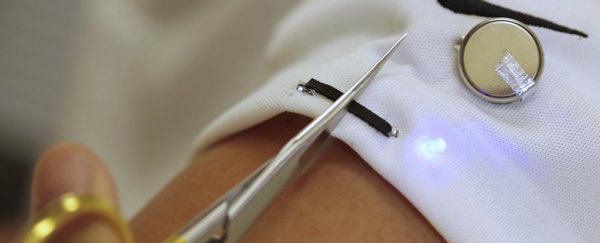Scientists have developed a self-healing electronic device that repairs itself when broken, using a special magnetic ink to bridge gaps as wide as 3 millimetres (0.12 inches) - a new record in the field.
The technology could be used in a variety of ways, including batteries and sensors for wearables, because it works much faster than other self-healing materials and requires no external input to carry out the patch-up job.
The researchers, from the University of California, San Diego, have crafted their microscopic magnetic particles into conductive materials such as graphite, gold, and silver, so it can potentially be used in all kinds of ways, including electrical circuits embedded in clothing.
"We wanted to develop a smart system with impressive self-healing abilities with easy-to-find, inexpensive materials," said one of the team, Amay Bandodkar, now at Northwestern University.
The team started with magnetic microparticles made of neodymium - a cheap, conductive metal commonly used for research and known for its particles' large magnetic fields, enabling them to attract each other over a gap of a few millimetres.
Neodymium isn't particularly suited to electrochemicals, though, so the scientists added carbon black to the mix - often used in devices like sensors and batteries - to give their ink all the properties it needed to both function well and repair itself.
The final problem was the microparticles' magnetic fields, which cancelled each other out in their natural configuration. The team printed the ink alongside an external magnetic field to ensure that the particles were correctly oriented and would attract each other if split apart.
To demonstrate their new ink, the researchers put a self-healing circuit on the sleeve of a t-shirt along with a LED light and battery, then cut through it with a pair of scissors. Within a few seconds, the circuit was repaired and the light switched on again.
The researchers say damage is repaired in about 50 milliseconds or 0.05 seconds. The ink can also pull devices back together if they're repeatedly damaged in the same spot.
Imagine smart jeans that can keep counting your steps after getting into a scrape, or a smartwatch that keeps ticking even as its battery is bent out of shape – that's the kind of potential we're talking about here.
There is a visible scar left behind by breaks and tears, though, even after the electronics have reconnected.
Another problem the team needs to overcome is finding ways to stop the magnetic field from interfering with other devices without adding a lot of bulk or a lot of expense to the process.
"Our work holds considerable promise for widespread practical applications for long-lasting printed electronic devices," said team leader Joseph Wang.
The group's work has been published in Science Advances.
